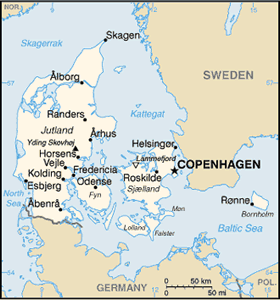The Geography of Denmark
The Geography of Denmark
Danish Geography
Location: Northern Europe, bordering the Baltic Sea and the North Sea, on a peninsula north of Germany (Jutland); also includes two major islands (Sjaelland and Fyn)
Geographic coordinates: 56 00 N, 10 00 E
Map references: Europe
Area: total: 43,094 sq km land: 42,394 sq km water: 700 sq km note: includes the island of Bornholm in the Baltic Sea and the rest of metropolitan Denmark (the Jutland Peninsula, and the major islands of Sjaelland and Fyn), but excludes the Faroe Islands and Greenland
Area - comparative: slightly less than twice the size of Massachusetts
Land boundaries: total: 68 km border countries: Germany 68 km
Coastline: 7,314 km
Maritime claims: territorial sea: 12 nm contiguous zone: 24 nm exclusive economic zone: 200 nm continental shelf: 200 m depth or to the depth of exploitation
Climate: temperate; humid and overcast; mild, windy winters and cool summers
Terrain: low and flat to gently rolling plains
Elevation extremes: lowest point: Lammefjord -7 m highest point: Yding Skovhoej 173 m
Natural resources: petroleum, natural gas, fish, salt, limestone, chalk, stone, gravel and sand
Land use: arable land: 52.59% permanent crops: 0.19% other: 47.22% (2005)
Irrigated land: 4,490 sq km (2003)
Natural hazards: flooding is a threat in some areas of the country (e.g., parts of Jutland, along the southern coast of the island of Lolland) that are protected from the sea by a system of dikes
Environment - current issues: air pollution, principally from vehicle and power plant emissions; nitrogen and phosphorus pollution of the North Sea; drinking and surface water becoming polluted from animal wastes and pesticides
Environment - international agreements: party to: Air Pollution, Air Pollution-Nitrogen Oxides, Air Pollution-Persistent Organic Pollutants, Air Pollution-Sulfur 85, Air Pollution-Sulfur 94, Air Pollution-Volatile Organic Compounds, Antarctic Treaty, Biodiversity, Climate Change, Climate Change-Kyoto Protocol, Desertification, Endangered Species, Environmental Modification, Hazardous Wastes, Law of the Sea, Marine Dumping, Marine Life Conservation, Ozone Layer Protection, Ship Pollution, Tropical Timber 83, Tropical Timber 94, Wetlands, Whaling signed, but not ratified: none of the selected agreements
Geography - note: controls Danish Straits (Skagerrak and Kattegat) linking Baltic and North Seas; about one-quarter of the population lives in greater Copenhagen


